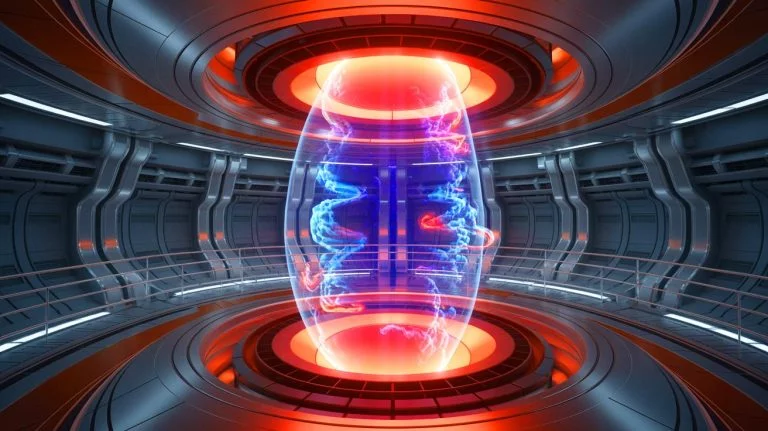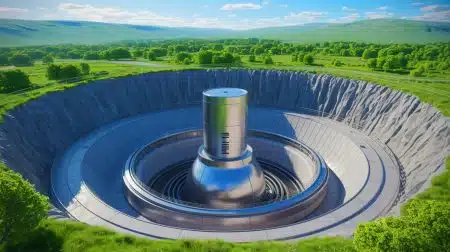| IN A NUTSHELL |
|
Recent advancements in nuclear fusion research have brought focus to the enigmatic plasma boundary, a critical component in sustaining fusion reactions. Researchers from the University of California, San Diego, have developed a groundbreaking theoretical model that sheds light on previously misunderstood structures known as “voids.” These insights could be pivotal in resolving discrepancies in fusion energy research, particularly in the context of tokamaks—advanced devices designed for controlled nuclear fusion. As the scientific community explores these new findings, the potential for achieving a sustainable fusion reaction seems closer than ever.
Understanding the Plasma Boundary
The plasma boundary is a key area of interest in nuclear fusion research, particularly in the operation of tokamaks. These advanced devices use powerful magnetic fields to confine plasma at temperatures reaching millions of degrees Fahrenheit. The plasma boundary, however, presents a complex layer of turbulence that has historically puzzled scientists. Known as the “shortfall problem,” this issue arises when computer simulations fail to accurately predict the behavior of the turbulent layer at the plasma’s edge.
Maintaining the right conditions at this boundary is crucial for sustaining nuclear fusion reactions and protecting reactor components from extreme heat. The inability to account for this turbulence has been a significant obstacle in the development of reliable fusion reactors. Therefore, a deeper understanding of the plasma boundary’s physics is essential for advancing fusion technology.
The Role of “Voids”
The recent research conducted at UC San Diego has redirected attention to the processes occurring at the plasma’s outer boundary. This region undergoes dynamic changes, characterized by gradient relaxation events that produce distinct structures. While past research primarily focused on outward-moving “blobs,” the inward-moving “voids” had remained largely unexplored.
These voids, which move inward from the plasma boundary, play a crucial role in the dynamics of edge-core coupling. The study by physicists Mingyun Cao and Patrick Diamond proposes that voids function as coherent, particle-like entities. By treating voids in this manner, the researchers could analyze their impact on plasma behavior, offering new insights into the mechanisms driving turbulence.
A New Model for Turbulence Generation
The groundbreaking model developed by Cao and Diamond highlights a previously overlooked mechanism for turbulence generation. According to their findings, as a void moves from the cooler plasma edge toward the hotter core, it traverses steep temperature and density gradients. This movement generates plasma drift waves, which facilitate the transfer of energy and momentum, ultimately creating additional local turbulence.
This novel mechanism could explain the extra turbulence observed in experiments, which earlier models failed to account for. If validated, this model could significantly enhance the accuracy of predictive simulations, aiding in the design of future reactors and improving plasma control techniques. The study underscores the importance of understanding void dynamics for optimizing fusion reactions.
Implications for Future Research
The model proposed by the UC San Diego researchers remains theoretical, but it holds significant promise for the future of nuclear fusion research. By offering a potential solution to the shortfall problem, this model could lead to more reliable predictions of plasma behavior. Such advancements are crucial for the development of efficient fusion reactors capable of providing a sustainable energy source.
If further experiments validate the model, it could revolutionize the approach to plasma control and reactor design. As the scientific community continues to explore these findings, the potential for achieving controlled nuclear fusion becomes increasingly tangible. This research not only addresses longstanding questions but also paves the way for innovative techniques in fusion technology.
As researchers delve deeper into the mysteries of the plasma boundary, the quest for sustainable nuclear fusion energy continues to evolve. With the potential solutions offered by this new model, the future of fusion research looks promising. What other breakthroughs lie ahead in the pursuit of harnessing the power of the stars?
Did you like it? 4.4/5 (29)






Wow, this sounds like a game-changer for fusion energy! 🚀
Are these “voids” similar to black holes in space?
Finally! Some progress in fusion tech. Hope it leads to practical applications soon.
I’m skeptical. How many times have we heard about fusion breakthroughs that lead nowhere?
What exactly are voids, and how do they differ from blobs?
Thanks to the researchers for their hard work. Keep pushing the boundaries! 🙏
Does this mean cheaper electricity for everyone in the near future?
Why did it take decades to discover these voids?
Great article, but could use more diagrams to explain the concepts.
Exciting news! The stars’ power might be within our reach. ⭐️
Will this discovery speed up the development of commercial fusion reactors?
Can someone explain how this affects the average person?
Is there any chance this could lead to nuclear fusion-powered cars? 😄
How do these findings impact other types of nuclear reactors, if at all?
I’m glad to see UC San Diego leading the charge on this!
If these voids are real, why didn’t anyone notice them before?
Hope to see more articles on this topic, very interesting!
Are there any immediate plans to test this model in existing reactors?
Fusion energy is always 30 years away… let’s hope this changes that! 🤞
Can these voids be controlled, or do they just do their own thing?
I’m confused. How does this discovery help solve the energy crisis?
Seems like a lot of theoretical stuff. When will we see real-world results?
So, are voids good or bad for fusion reactions?
Will this affect the cost of building fusion reactors?
Why isn’t this headline news? This is huge! 📰
How many other unrecognized structures might there be in plasma?
Is this a US-only discovery, or are other countries involved too?
Can this new model be applied to other fields of physics?
So proud of the scientific community for not giving up on fusion!
This sounds like a step closer to limitless clean energy. 🌍
Hope this doesn’t get buried like other scientific discoveries. It’s too important!